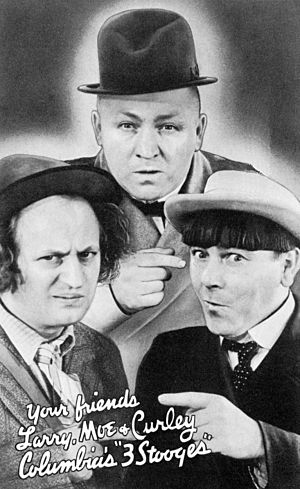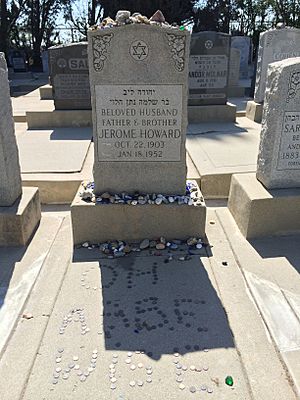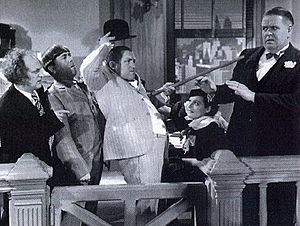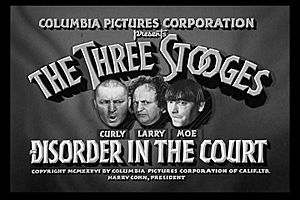Curly Howard facts for kids
Quick facts for kids
Curly Howard
|
|
|---|---|
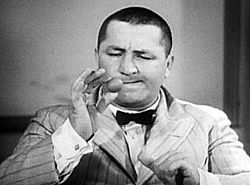
Curly Howard in Disorder in the Court
|
|
| Born |
Jerome Lester Horwitz
October 22, 1903 |
| Died | January 18, 1952 (aged 48) San Gabriel, California, U.S.
|
| Cause of death | Cerebral hemorrhage |
| Resting place | Home of Peace Cemetery, East Los Angeles, California, U.S. |
| Other names | Jerry Howard Jerome Howard |
| Occupation | Comedian, actor |
| Years active | 1918–1947 |
| Height | 5 ft 5 in (1.65 m) |
| Spouse(s) |
|
| Children | 2 |
| Relatives | Moe Howard (brother) Shemp Howard (brother) Joan Howard Maurer (niece) |
Jerome Lester Horwitz (October 22, 1903 – January 18, 1952), better known by his stage name Curly Howard, was an American comedian and vaudevillian actor. He was best known as a member of the American farce comedy team, the Three Stooges, which also featured his elder brothers Moe and Shemp Howard and actor Larry Fine.
Curly was generally considered the most popular and recognizable of the Stooges. He was well known for his high-pitched voice and vocal expressions ("nyuk-nyuk-nyuk!", "woob-woob-woob!", "soitenly!" [certainly], and barking like a dog) as well as his physical comedy (e.g., falling on ground and pivoting on his shoulder as he "walked" in circular motion), improvisations, and athleticism.
Curly was forced to leave the Three Stooges act in 1946 when a massive stroke ended his showbusiness career. He suffered through serious health problems and several more strokes until his death in 1952 at age 48.
Contents
Early life
Curly Howard was born Jerome Lester Horwitz in the Bensonhurst section of the Brooklyn borough of New York City, on October 22, 1903. He was the youngest of the five sons. Because he was the youngest, his brothers called him "Babe" to tease him. The name "Babe" stuck with him all his life, although when his elder brother Shemp Howard married Gertrude Frank, who was also nicknamed "Babe," the brothers called him "Curly" to avoid confusion. His full formal Hebrew name was "Yehudah Lev ben Shlomo Natan ha Levi."
A quiet child, Curly rarely caused problems for his parents (something older brothers Moe and Shemp excelled in). He was a mediocre student but excelled as an athlete on the school basketball team. He didn't graduate from high school, and instead he kept himself busy with odd jobs and constantly following his older brothers, whom he idolized. He was also an accomplished ballroom dancer and singer.
When Curly was 12, he accidentally shot himself in the left ankle while cleaning a rifle. Moe rushed him to the hospital and saved his life. The wound resulted in a noticeably thinner left leg and a slight limp. He was so frightened of surgery that he never had the limp corrected. While with the Stooges, he developed his famous exaggerated walk to mask the limp on screen.
Curly was interested in music and comedy and would watch his brothers Shemp and Moe perform as stooges in Ted Healy's vaudeville act. He also liked to hang around backstage, although he never participated in any of the routines.
Prime years
Curly's childlike mannerisms and natural comedic charm made him a hit with audiences, particularly children. He was known in the act for having an "indestructible" head, which always won out by breaking anything that assaulted it, including saws (resulting in his characteristic quip, "Oh, look!"). Although having no formal acting training, his comedic skills were exceptional.
Many times, directors would simply let the camera roll freely and let Curly improvise. Jules White, in particular, would leave gaps in the Stooge scripts where Curly could improvise for several minutes. In later years, White commented: "If we wrote a scene and needed a little something extra, I'd say to Curly, 'Look, we've got a gap to fill this in with a "woob-woob" or some other bit of business.' And he never disappointed us."
By the time the Stooges hit their peak in the late 1930s, their films had almost become vehicles for Curly's unbridled comic performances. Classics like A Plumbing We Will Go (1940), We Want Our Mummy (1938), An Ache in Every Stake (1941), and Cactus Makes Perfect (1942) display his ability to take inanimate objects (like food, tools, pipes, etc.) and turn them into ingenious comic props. Moe later confirmed that when Curly forgot his lines, that merely allowed him to improvise on the spot so that the "take" could continue uninterrupted:
If we were going through a scene and he'd forget his words for a moment, you know, rather than stand, get pale and stop, you never knew what he was going to do. On one occasion he'd get down to the floor and spin around like a top until he remembered what he had to say.
Curly also developed a set of reactions and expressions that the other Stooges would imitate long after he'd left the act:
- "Nyuk, nyuk, nyuk" – Curly's traditional laughter, accompanied by manic finger-snapping, often used to amuse himself;
- "Woob, woob, woob!" – used when he was either scared, dazed, or flirting with a "dame";
- "Hmmm!" – an under-the-breath, high-pitched sound meant to show different emotions, including interest, excitement, frustration, or anger; one of his most-used reactions/expressions;
- "Nyahh-ahhh-ahhh!" – scared reaction (this was the reaction most often used by the other Stooges after Curly's departure);
- "Laaa-Deeeeeee" or simply "Laaa, laaa, laaa" – Curly's working "song"; also used when he was acting innocently right before taking out an enemy;
- "Ruff Ruff" – dog bark, used to give an enemy a final push before departing the scene, or barking at an attractive dame;
- "Ha-cha-cha-cha-cha!" – a take on Jimmy Durante's famed call, used more sparingly than other expressions;
- "I'm a victim of soicumstance [circumstance]";
- "Soiteny!" ("certainly");
- "Huff huff huff!" – sharp, huffing exhales either due to excitement or meant to provoke a foe;
- "Ah-ba-ba-ba-ba-ba-ba!" – used during his later years, a sort of nonsense, high-pitched yelling that signified being scared or overly excited;
- "Indubitably" – an expression used to feign an intelligent response;
- Curly's teeth, while chattering nervously, made the sound of a small hammer striking a chisel;
- "A WISE Guy, Eh?" – annoyed response;
- "Oh Look!" – surprised remark, usually about a common object;
- "Say a coupla adjectives!" – to another (injured) stooge, usually Moe.
- Occasionally, the Stooges faced a problem that required deep thought; whereupon Curly would bang his head on a wall several times, then shout, "I got it! I got it!" Moe would ask, "What have you got?" Curly's answer: "A terrific headache."
On several occasions, Moe was convinced that rising star Lou Costello (a close friend of Shemp) was stealing material from Curly. Costello was known to acquire prints of the Stooges' films from Columbia Pictures on occasion, presumably to study Curly. Inevitably, Curly's routines would show up in Abbott and Costello feature films, much to Moe's chagrin. (It did not help that Columbia Pictures president Harry Cohn would not allow the Stooges to make feature-length films like contemporaries Laurel and Hardy, the Marx Brothers, and Abbott and Costello.)
Final months and death
In December 1951, the North Hollywood Hospital and Sanitarium supervisor advised the Howard family that Curly was becoming a problem to the nursing staff at the facility because of his mental deterioration. They admitted they could no longer care for him and suggested he be placed in a mental hospital. Moe refused and relocated him to the Baldy View Sanitarium in San Gabriel, California.
On January 7, 1952, Moe was contacted on the Columbia set while filming He Cooked His Goose to help move Curly for what would be the last time. Eleven days later, on January 18, Curly died. Curly lived the shortest life of the Stooges, dying at the age of 48. He was given a Jewish funeral and laid to rest at the Western Jewish Institute section of Home of Peace Cemetery in East Los Angeles. Curly's older brothers, Benjamin and Shemp, and parents Jennie and Solomon are all interred there as well.
Legacy
Curly Howard is considered by many fans and critics alike to be their favorite member of The Three Stooges. In a 1972 interview Larry Fine recalled, "Personally, I thought Curly was the greatest because he was a natural comedian who had no formal training. Whatever he did, he made up on the spur of the moment. When we lost Curly, we took a hit." Curly's mannerisms, behavior and personality along with his catchphrases of "n'yuk, n'yuk, n'yuk," "woob, woob, woob" and "soitenly!" have become a part of American popular culture. Steve Allen called him one of the "most original, yet seldom recognized, comic geniuses."
In 2000, longtime Stooges fan Mel Gibson produced a television film for ABC about the life and careers of the Stooges. In an interview promoting the film, he said Curly was his favorite of the Stooges. In the film, Curly was played by Michael Chiklis.
In the 2012 Farrelly brothers' film The Three Stooges, Will Sasso portrays Curly. Robert Capron portrays Young Curly.
In the children's novel series Captain Underpants and its film adaptation, the elementary school that the main characters attend is named Jerome Horwitz Elementary School, in reference to Howard's birth name.
Filmography
Features
- Turn Back the Clock (1933)
- Broadway to Hollywood (1933)
- Meet the Baron (1933)
- Dancing Lady (1933)
- Myrt and Marge (1933)
- Fugitive Lovers (1934)
- Hollywood Party (1934)
- The Captain Hates the Sea (1934)
- Start Cheering (1938)
- Time Out for Rhythm (1941)
- My Sister Eileen (1942)
- Good Luck, Mr. Yates (1943) (scenes deleted, reused in Gents Without Cents)
- Rockin' in the Rockies (1945)
- Swing Parade of 1946 (1946)
- Stop! Look! and Laugh! (1960) (scenes from Stooge shorts)
Short subjects
- Nertsery Rhymes (1933)
- Beer and Pretzels (1933)
- Hello Pop! (1933)
- Plane Nuts (1933)
- Roast Beef and Movies (1934)
- Jail Birds of Paradise (1934)
- Hollywood on Parade # B-9 (1934)
- Woman Haters (1934) (*credited as "Curley")
- The Big Idea (1934)
- Punch Drunks (1934)
- Men in Black (1934)
- Three Little Pigskins (1934)
- Horses' Collars (1935)
- Restless Knights (1935)
- Screen Snapshots Series 14, No. 6 (1935)
- Pop Goes the Easel (1935)
- Uncivil Warriors (1935)
- Pardon My Scotch (1935)
- Hoi Polloi (1935)
- Three Little Beers (1935)
- Ants in the Pantry (1936)
- Movie Maniacs (1936)
- Screen Snapshots Series 15, No. 7 (1936)
- Half Shot Shooters (1936)
- Disorder in the Court (1936)
- A Pain in the Pullman (1936)
- False Alarms (1936)
- Whoops, I'm an Indian! (1936)
- Slippery Silks (1936)
- Grips, Grunts and Groans (1937)
- Dizzy Doctors (1937)
- Three Dumb Clucks (1937)
- Back to the Woods (1937)
- Goofs and Saddles (1937)
- Cash and Carry (1937)
- Playing the Ponies (1937)
- The Sitter Downers (1937)
- Termites of 1938 (1938)
- Wee Wee Monsieur (1938)
- Tassels in the Air (1938)
- Healthy, Wealthy and Dumb (1938)
- Violent Is the Word for Curly (1938)
- Three Missing Links (1938)
- Mutts to You (1938)
- Flat Foot Stooges (1938)
- Three Little Sew and Sews (1939)
- We Want Our Mummy (1939)
- A Ducking They Did Go (1939)
- Screen Snapshots: Stars on Horseback (1939)
- Yes, We Have No Bonanza (1939)
- Saved by the Belle (1939)
- Calling All Curs (1939)
- Oily to Bed, Oily to Rise (1939)
- Three Sappy People (1939)
- You Nazty Spy! (1940)
- Screen Snapshots: Art and Artists (1940)
- Rockin' thru the Rockies (1940)
- A Plumbing We Will Go (1940)
- Nutty but Nice (1940)
- How High Is Up? (1940)
- From Nurse to Worse (1940)
- No Census, No Feeling (1940)
- Cookoo Cavaliers (1940)
- So Long Mr. Chumps (1941)
- Dutiful but Dumb (1941)
- All the World's a Stooge (1941)
- I'll Never Heil Again (1941)
- An Ache in Every Stake (1941)
- In the Sweet Pie and Pie (1941)
- Some More of Samoa (1941)
- Loco Boy Makes Good (1942)
- What's the Matador? (1942)
- Cactus Makes Perfect (1942)
- Matri-Phony (1942)
- Three Smart Saps (1942)
- Even as IOU (1942)
- Sock-a-Bye Baby (1942)
- They Stooge to Conga (1943)
- Dizzy Detectives (1943)
- Spook Louder (1943)
- Back from the Front (1943)
- Three Little Twirps (1943)
- Higher Than a Kite (1943)
- I Can Hardly Wait (1943)
- Dizzy Pilots (1943)
- Phony Express (1943)
- A Gem of a Jam (1943)
- Crash Goes the Hash (1944)
- Busy Buddies (1944)
- The Yoke's on Me (1944)
- Idle Roomers (1944)
- Gents Without Cents (1944)
- No Dough Boys (1944)
- Three Pests in a Mess (1945)
- Booby Dupes (1945)
- Idiots Deluxe (1945)
- If a Body Meets a Body (1945)
- Micro-Phonies (1945)
- Beer Barrel Polecats (1946)
- A Bird in the Head (1946)
- Uncivil War Birds (1946)
- The Three Troubledoers (1946)
- Monkey Businessmen (1946)
- Three Loan Wolves (1946)
- G.I. Wanna Home (1946)
- Rhythm and Weep (1946)
- Three Little Pirates (1946)
- Half-Wits Holiday (1947)
- Hold That Lion! (1947, cameo appearance)
- Malice in the Palace (1949, cameo appearance filmed but not used)
- Booty and the Beast (1953, recycled footage from Hold That Lion!)
Images for kids
See also
 In Spanish: Curly Howard para niños
In Spanish: Curly Howard para niños


